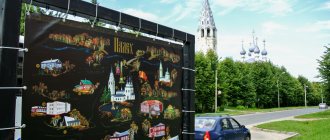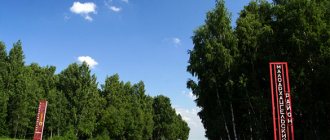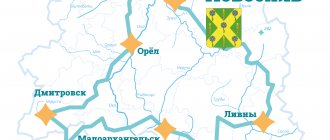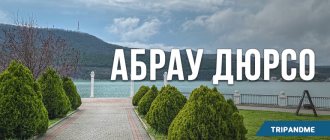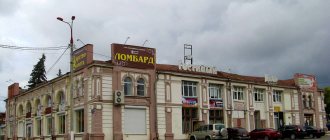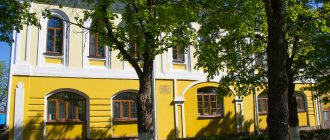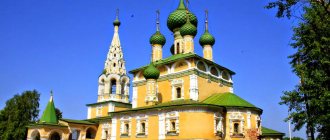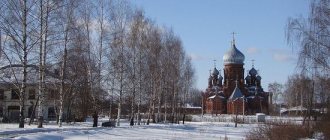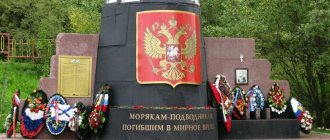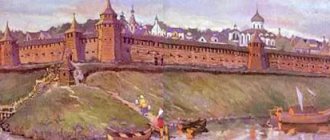Goethe himself dreamed of visiting this city, because here, according to him, uneducated peasants created divine images. This small village in the Ivanovo region is famous for its master painters. Starting from the 14th century, folk crafts flourished here and icon painting began. Today it is included in the mandatory excursion program to the cities of the Golden Ring of Russia and is very popular among tourists. All this is Palekh. Let's look at its main attractions with descriptions and photos.
What to see in Palekh in 1 day – TOP-3
To see all the sights of Palekh and visit all the exhibitions, one day is very little - you need at least a week. Therefore, if you are short on time, you can pay attention only to the most important city objects. They, like nothing else, fully convey the entire originality of the ancient town.
House of Crafts
- Address: st. Lenina, 42.
It was opened in 1991 and today belongs to the municipality. The gallery is located in one of the ancient buildings, which once belonged to the famous restorer and icon painter N.M. Sofonov, one of the suppliers of the Court of His Imperial Majesty. This house housed workshops and a school for artists.
To this day, Sofonov’s personal rooms have been preserved unchanged, and the façade of the building is still decorated with forged metal gratings and a forged canopy over the front door. Tourists have the opportunity to see this by coming here on a tour. Here you can learn more about Russian life, ancient Russian painting and the history of crafts. It is also easy to attend master classes on creating a spinning doll and Palekh painting.
Various clubs and studios are open for children and teenagers at the House of Crafts. Here young residents of Palekh learn birch bark knitting, painting and artistic woodworking, making clay toys and patchwork. Every year the gallery hosts holidays, folk festivals and thematic exhibitions dedicated to Russian life.
State Museum of Palekh Art
- Address: st. Bakanova, 50.
Writer Maxim Gorky and art critic Anatoly Bakushinsky had a hand in opening this museum in Palekh. In 1934, the People's Commissariat of Education approved this idea, and already in 1935 the first exhibition took place.
Initially, the exhibition consisted only of lacquer miniatures provided by the Artel of Ancient Painting. A year later, it was replenished with magnificent examples of icon painting from the Church of the Exaltation of the Cross. In 2014, the museum collection grew to such an extent that there was no longer enough space for the exhibits, so it was decided to allocate a new building for them.
Today's exhibitions include more than 10,000 icons, lacquer miniatures, paintings by Palekh painters, as well as Italian, Flemish and German artists from the 14th to the 19th centuries.
The museum's information collections include more than 8,000 book publications, among which there are quite rare and valuable copies. The branches of the museum are the houses of famous artists of Palekh, such as P. Korin, N. Dydykin, N. Zinoviev, etc.
Holy Cross Cathedral
- Address: st. Lenina, 16A.
This Orthodox church is of great interest to tourists, because it is unique in its architectural style and has interesting examples of icon painting from the 18th century. The church was built at the end of the 17th century. in the Moscow Baroque, which is often called Naryshkinsky, according to the project of E. Dubov.
The construction was carried out at the expense of the residents of Palekh. The five domes of the temple, sparkling with gold, are visible from afar, and on church holidays a bell chime is heard from the bell tower.
The inside of the temple is decorated with frescoes using graffiti techniques, which were created jointly by Moscow and Palekh masters and were repeatedly restored and changed. The special pride of the parish is the baroque iconostasis made by Samara masters - the Belousov brothers.
Among the rare icons belonging to the cathedral are Fr. and “The Savior in Power,” the plot of which represents the earthly and heavenly worlds. In addition, the temple owns a wooden sculpture by one of the local craftsmen, personifying Christ in prison.
After the events of 1917, the church was closed, the rector was shot, and the building was given to the museum. After the collapse of the USSR, the Orthodox Church regained the temple, which became the courtyard of the Nikolo-Shartomsky Monastery, and in 2012 received the status of a Cathedral.
Don't miss - Sights of the Ivanovo region
Villa Barbarigo - beautiful gardens
30 km separate Padua from the wonderful country estate of the Barbarigo family. The romantic villa has been preserved in its original form, but you can only view it from the outside: the interior is closed. Despite this, tourists willingly come here to admire the unique gardens, designed in the Baroque style.
Villa Barbarigo. Fulcanelli
Behind the graceful baroque arch, called "Diana", there are pools, canals, many statues and flower beds. The pride of the garden is a boxwood labyrinth, all paths of which lead to a cozy gazebo. You can visit the garden only in summer; in winter it opens by reservation.
Pond at Villa Barbarigo. Luca Lorenzelli
Address: Via Diana, 2, 35030 Valsanzibio
Schedule: the garden is open on weekends and holidays from 10 to 13 and from 14 to sunset
Tickets: 11€
Excursions: organized at 11 a.m. and 3 p.m. (May-August), cost 5 € in addition to the ticket price.
Website: https://www.valsanzibiogiardino.it
The most interesting museums of Palekh
Museum exhibitions in Palekh are represented by houses where famous artists and restorers lived and worked. Here you can see not only the works of masters, but also household items that they used during their lifetime.
House-Museum of I.I. Golikova
- Address: st. Lenina, 2.
Since 1928, this mansion has not changed at all and looks exactly the same as during the artist’s lifetime. The exhibition consists of two parts. One of them, a memorial one, is dedicated to Golikov himself. Here you can learn the history of his family and see the personal belongings of the famous artist.
The second part is devoted to the creation of the Artel of Ancient Painting and talks about the history of lacquer miniatures. On separate stands you can see unique photographs capturing views of old Palekh, and one of them describes the process of creating a Palekh box from the very beginning to the end.
House-Museum of N.V. Dydykina
- Address: st. Lenina, 25A.
This museum is located in the very center of Palekh. Tourists are invited to visit the family estate of the famous sculptor and restorer, hidden under the canopy of linden trees. Nikolai Vasilyevich Dydykin came from a family of hereditary icon painters; in his youth he studied this craft in Sofonov’s workshops and studied the works of Andrei Rublev. Even as a teenager, he took part in the restoration of the Ipatiev Monastery.
A little later, he began to show interest in sculpture, took courses with the famous sculptor G. Manizer, and distinguished himself by being able to most accurately convey proportions and forms.
Dydykin's very first works to gain recognition were portraits of writers and political figures of the USSR. His chisel belongs to the famous sculptures “Sheaf Knitter” and “Wounded Soldier”, and the most famous is the monument to A.S. Pushkin on the Moika embankment.
In 1978, the memorial museum in the family estate received its first visitors. More than 100 works by the master, which he bequeathed to the city, are presented here. Among them are busts and bas-reliefs of famous people and relatives of the sculptor.
House-Museum of N.M. Zinoviev
- Address: Palekh district, Dyagilevo village, 26.
N.M. Zinoviev is another artist from the hereditary icon painters of Palekh. At first, the young artist was educated by his father, then he was sent to study at the School of Icon Painting. After that, he was engaged in the fact that, together with other masters, he took part in the restoration and painting of temples. One of the most famous pre-revolutionary works of Zinoviev were the wall frescoes of the monastery on New Athos.
After the establishment of Soviet power, he became widely known as a restorer, author of wall paintings and analyst of Palekh art. Several books have come out from his pen, which tell about the origins of icon painting in the vicinity of Palekh and the work of masters of lacquer miniatures. In the post-war years, he was mainly involved in restoration. With his participation, the external painting of the Assumption Cathedral and the famous lacquer cabinet in Monplaisir, one of the palaces of Peterhof ( St. Petersburg ), were restored.
The opening of the memorial museum in his memory was timed to coincide with the 60th anniversary of Palekh art in 1984. The doors of the ancestral house in the village of Diaghilevo opened to visitors. In this small house, the life of the Russian village has been completely preserved: simple furniture, embroidered pillowcases, a starched tablecloth on the table and, as the center of life, a large Russian stove.
The artist always remembered his home with warmth and love, because his whole life passed in it, the best works were created. Zinoviev’s friends also loved him, the hospitable hosts greeted everyone with bread and salt, gathering a variety of people under the old roof. Today this house is also full of people, but they come to it in order to honor the memory of this famous artist and just a Man.
Memorial house-museum of P.D. Corina
- Address: st. Demyan Bedny, 19.
The story of People's Artist of the USSR P. Korin is similar to the stories of other Palekh masters. A hereditary icon painter in the tenth generation, it is natural that he entered the School of Icon Painting. After graduating, he went to Moscow and began working as a full-time icon painter at the Donskoy Monastery. There he met M. Nesterov, and this meeting changed his entire work. But even living in Moscow , the artist did not forget his origins, his small homeland, which gave him life and talent.
The wooden house of Korin is one of the oldest in the city of Palekh. It was built in the 1860-70s. Even during his lifetime, the artist dreamed of setting up a museum in it, where household and creative objects belonging to more than one generation would be collected. His will was done. After Corin's death, his brother and sister gave the house to the city along with all its furnishings. And now, for 40 years, its doors have been open to visitors and fans of Palekh folk craft.
Among the exhibits presented in the house-museum you can see the works of the artist’s great-grandfather, grandfather, father, some of his first works. Ancient paints used for icon painting, brushes, boards, engravings. One of the rooms is occupied by a large library, which contains not only works of Russian and foreign classics, but also religious publications, scientific and archaeological literature.
In the room, which has always been called the “red” room, you can see a real Dutch oven decorated with tiles. It also contains antiques that belonged to the artist’s great-grandfather and a home iconostasis with the “Burning Bush” and “Resurrection with the Holidays” icons. The walls of the house are decorated with portraits of the owners and their ancestors.
Museum of Icons
- Address: st. Lenina, 6.
This museum complex was opened recently - in 2014. A large collection of icons, the work of local artists, moved to the new building, next to the Church of the Exaltation of the Holy Cross. Images of Palekh icon painters of the 18th century were also brought here from neighboring regions: Vologda, Novgorod, Arkhangelsk.
The museum's collection also contains icons from closed churches and even an Old Believer crucifix. Even those who are far from this will be interested in studying the work of Palekh masters, comparing it with other schools of icon painting and assessing the originality, spirituality and morality of artists faithful to their holy work.
Art workshop “Palekh style”
- Address: st. Zinovieva, 2V.
In the western part of the village of Palekh, behind the City Hospital, there is an art workshop “Palekh Style”, which is recommended for all tourists who come to the town to visit. Why is this place interesting? During the excursion here you will be allowed to take part in a master class, during which you or your children (the attraction will be interesting for children aged 6 years and older) will be able to create a real miracle with your own hands by applying varnish to wooden or plastic products. In addition, polite and efficient staff will tell you a lot of interesting things about Palekh crafts, show you the most interesting exhibits, and also offer to buy memorable souvenirs.
Where to find private excursions in Padua and its surroundings: the best services for tourists
A walk around the city in the company of a professional guide is a great opportunity to combine business with pleasure! You will not only get tremendous emotions, but also add interesting facts about the resorts to your knowledge base. As a bonus - useful practical information. You will be able to find out where to dine at reasonable prices, how not to waste money on souvenirs, what features of the national mentality are worth remembering, etc.
Where can you find such a knowledgeable guide?
Tripster and Sputnik services have dozens of offers for the most popular cities in the world. Each available excursion is accompanied by a detailed description, from which you can glean the necessary information:
- meeting point;
- indicative route;
- duration of the walk;
- permissible number of people in a group;
- cost and additional expenses.
In addition, you will also see reviews from other travelers. They will finally complete the picture and help you understand which excursion best meets your expectations.
Pay attention to the options offered by sites for Padua and nearby cities
Individual excursions in Padua and the surrounding area
- Padua is a city of three “withouts”;
- Meet Padua!;
- Explore Padua in 3 hours;
- Abano Terme - medical resort, excursion to medieval cities, tasting of local products;
- Cittadella is a fortified city.
Individual excursions in Venice
- Living Venice;
- Curiosities, legends and myths of Venice;
- First day in Venice;
- All of Venice in 2 hours;
- Gondola ride with serenade along the canals of Venice.
Individual excursions in Bologna
- Bologna - love at first sight;
- Bologna scientific, red, thick - for children and their parents;
- Bologna - first acquaintance;
- Welcome to Bologna!;
- Bologna is learned, well-fed, red...
Individual excursions in Verona
- Verona - first date;
- Verona from A to Z;
- "Shakespeare in Love": in the footsteps of Romeo and Juliet;
- Verona from the Romans to the present day;
- Sightseeing tour of Verona.
Palekh temples and monasteries
Palekh is truly a holy land. The entire life of local residents for many centuries was inextricably linked with serving God. It is not surprising that in the vicinity of this small town there are a large number of monasteries, churches and temples.
Church of the Icon of the Mother of God “Seeking the Lost”
- Address: st. Zinovieva, 44.
A small wooden church was founded in 1999. It was built over the course of 6 years with funds from the residents of Palekh, sponsors and the rector of the Elias Church, Abbot Philaret. The unique church belongs to the type of cemetery chapels and is used for memorial services and funerals.
On patronal feast days and on days of remembrance of the dead, the Divine Liturgy is celebrated there. The carved iconostasis, made in the best traditions of Palekh art, creates a special beauty inside the church building. It was produced by the masters of the city’s icon-painting workshop A.V. Vlezko and Yu.V. Fedorov.
Church of Elijah the Prophet
- Address: st. Gorky, 6.
This small cemetery church has existed for quite a long time. Initially, it was entirely wooden, but at the end of the 17th century the wood was replaced with brick, and the roof was first covered with tiles, then completely made of metal. The building is made in the form of a quadrangle with one dome. On the western side there is a refectory, adjacent to which is a bell tower.
The interior paintings, made by the masters of the Sofonovo artel, were destroyed during Soviet times, as were part of the tombstones in the adjacent cemetery. The temple was turned into a warehouse, and the chapel standing nearby was completely destroyed. It was possible to return the church only in 1989, at which time the restoration of the desecrated interior began. All work on the restoration of wall paintings was carried out by Palekh masters, in accordance with the ancient traditions of icon painting.
Church of the Transfiguration
- Address: Bolshie Dorki village.
A snow-white stone church with domes covered with azure is located in the village of Bolshie Dorki. Previously, in its place there was a wooden church with chapels of St. Nicholas the Wonderworker and St. Apostle Nikanor. Today it stands in the center of the village square, at the intersection of two main streets.
Chapel of Alexander Nevsky
- Address: st. Lenina, 59.
Today's chapel is a copy of the destroyed pre-revolutionary one. It was restored mainly at the expense of the parishioners and the rector of the Elias Church. There is a legend that the place for its laying was chosen for a reason. Prince Alexander Nevsky himself stayed here, in whose honor it received its name. However, local residents themselves are confused, sometimes saying that the relics of the holy prince were brought to this place. The consecration of the chapel took place in 2008, conducted by Bishop Joseph of Ivanovo-Voznesensk and Kineshma.
Znamenskaya Church
- Address: s. Red.
It is located near Palekh, in the village of Krasnoye. This is the only church in the area that has not been destroyed or beheaded for 200 years. The building dates back to 1804. It was erected on the site of an old churchyard with a wooden chapel. Funds for construction were provided by the landowner Buturlin.
The snow-white temple has several extensions and a front arched gate, and in the 19th century a porch and porticoes were added to it from the north and south. The temple building is surrounded by an openwork wrought-iron fence with brick columns. Behind it is the priest's house. The interiors of the church completely follow the traditions of Russian Orthodoxy. The subjects of the wall paintings were carried out by masters of Palekh icon painting based on the Old and New Testaments.
At the beginning of the 20th century, the temple was restored in the Fryazhsky style, and scenes from French masters were used for the frescoes. Therefore, today the Znamensky Church is a unique monument of religious culture, which harmoniously combines Russian and European trends in icon painting.
Ples city on the Volga historical attractions
The entire history of the emergence and development of the city is inextricably linked with the Volga, the population of Plyos is still small, less than 3,000 people permanently live here.
There are several ancient churches in the city. A famous landmark of Ples is the Church of the Resurrection of Christ, built in 1817, on Torgovaya Square (now it is Revolution Square). Many feature films were filmed in Ples. The Church of the Resurrection can be seen in the films: The Golden Calf, The Chinese Service, Two Captains, A Cruel Romance.
Opposite the church is the wooden chapel of St. Michael the Archangel from the village of Antonovo, built in 1825, and moved here in 1980. Now there is an exhibition hall of the Plyos Museum.
At the bottom of the former Trade Square there is Kalashnaya Street, the oldest street in Ples with shopping pavilions where you can buy local souvenirs and goods.
Cathedral Hill is located in the center - the heart of the city, from here its growth and development began. People have long lived on the banks of the Volga, not far from the confluence of the Shokhonka River.
In 1410, on the site of an existing settlement, Moscow Prince Vasily Dmitrievich, the son of Dmitry Donskoy, built a new fortress that controlled the trade route on the Volga and became part of the city’s customs and defense system. The first Plyos fortress was burned to the ground by Batu Khan in February 1238 during the Mongol-Tatar invasion.
On the protruding high bank of the Volga, bounded on both sides by deep ravines, is an ideal place for a fortress; the edge of the bank used to rise 50 meters above the water. The steep bank and ravines surrounding the mountain made it impregnable; on the side opposite the Volga, the fortress was protected by a deep ditch and rampart, the remains of which have been preserved here since 1410.
Ples attractions photo - Assumption Cathedral, 1699:
On Cathedral Hill there is the oldest temple in the city, the Assumption Cathedral, built in 1699. Opposite the cathedral is the building of the Public Offices to house the district administration, built in 1786 according to an exemplary design from Catherine's times. Later, at the end of the 19th century, there was a city government and a Higher Primary School here.
In 1910, the year of the celebration of the 500th anniversary of Plyos, a monument to the founder of the city, Grand Duke Vasily I, was erected on Cathedral Hill near the government building.
At the beginning of the 17th century, the Plyos fortress was burned by the troops of Pan Lisovsky, and the fortress was never restored. Now Sobornaya Hill is a favorite walking place for residents and guests of Plyos.
On the opposite side of the Volga from the Volga, the remains of a powerful fortress moat and rampart are visible. And along the entire perimeter of the mountain there is an alley with observation platforms from which the Volga can be seen for several kilometers.
Monuments and architecture of the city of Palekh
There are practically no sculptures, monuments or art objects in this ancient city. All valuables are concentrated in museum exhibits. However, memorials traditional for all Russian cities can be found here, as well as architectural buildings.
Monument to the fallen soldier
- Address: Lenin street.
The 14 m high obelisk in honor of the Paleshan soldiers who laid down their lives in the Great Patriotic War was erected in 1968. Traditionally, on holidays in honor of the Victory, residents and guests of the village gather around it, laying wreaths and flowers. On these same days, the Eternal Flame burns near him, and a soldier on a high pedestal, dressed in the uniform of the Soviet troops, clutches a sword in his hand. His whole appearance seems to say: “Don’t be afraid, the Motherland is under reliable protection!”
Bust of V.I. Lenin
- Address: Holy Cross Square.
The bronze leader of the world proletariat is also a tradition of its own for all cities of the post-Soviet space. It is rare that a city does not have a monument or bust in honor of this great man who changed the course of history. In Palekh, a bust of Vladimir Ilyich Ulyanov was installed in 1956 in the village square and is classified as an art monument of local significance.
House of Kotukhins
- Address: l. Demyan Bedny, 13.
There are also simply unusual and interesting architectural monuments in Palekh that should be protected by the state. The list of these includes a two-story mansion where the honored Soviet and Russian artists Kotukhins, Vladimir and Alexander, lived. The building is in satisfactory condition, although cracks are visible here and there on the facade - it cannot be repaired. It is made of red brick and has white painted windows.
How to get there?
regularly conducts trips to the cities of the Golden Ring of Russia.
Travel from Kazan
Travel from Cheboksary
Travel from Yoshkar-Ola
Considering creative products created by talented craftsmen, many ask the question of where Palekh is located. Most guests prefer to travel by private car. It's comfortable. The distance Moscow-Palekh is 400 kilometers. Traffic will be carried out along the M7 highway. You need to go through Vladimir and Suzdal. The total duration of the journey is 6-6.5 hours.
There is a daily bus to Palekh. Boarding is carried out from the Shchelkovsky railway station in Moscow. The stop is made at Yuzha station. There are also buses going from Moscow to Ivanovo. At the final station you will need to change to the Ivanovo-Palekh bus.
There is a railway connection. Shuya station is located 75 kilometers from the settlement. This solution is chosen by those traveling from St. Petersburg or Nizhny Novgorod. If you are heading from the capital, then a train with a direction such as Moscow-Kineshma will do, then you will need to transfer to a bus or use a taxi. Buses run frequently and the journey takes 1.5 hours.
If you want to avoid additional hassle, then book an excursion to Palekh from Moscow and other cities. The trip will be carried out on a comfortable bus accompanied by a guide.
Where to go in Palekh with a child. Entertainment
In such a small town as Palekh, it is difficult to find entertainment for children, but there are some, however, they will also be interesting for adults.
Krestovozdvizhensky Square
- Coordinates on the map: 56.802717, 41.855829.
The main park of the village surrounds its most important temple - the cathedral of the same name. Not to say that the walking area is too large, but still mothers with strollers often walk here, there is a small children’s playground, and there is a beautiful Kolos fountain, against which you can take photographs. Nearby there are several shops - grocery, meat, children's and souvenirs, the Administration building and banking institutions are located.
Palekhsky Palace of Culture
- Address: st. Bakanova, 19.
The House of Culture in Palekh also needs reconstruction. However, his building is quite remarkable in the form in which we see it now. There are several clubs for schoolchildren and kindergarten students here. Sometimes there are film screenings: the House of Culture is also a cinema. Nearby there is a city clinic and a fire station.
Village pond beach
- Address: Dorozhny Lane.
Oddly enough, there is even a beach in Palekh, although it is small and does not differ in any special features. An ordinary edge where villagers swim, on a river that flows through the village, forming several ponds in places.
Be sure to look at guides for other cities in the Ivanovo region - Yuryevets, Ivanovo, Gavrilov Posad, Shuya, Kineshma and Ples.
Of course, architectural monuments include perfectly preserved wooden houses, decorated with ancient carvings, and the unique nature in the vicinity of the Paleshki River. For this reason alone, it’s worth including Palekh on your excursion list. And having tasted the amazing energy of the ancient settlement, you will undoubtedly want to return again and again. After all, in a short time it is impossible to enjoy the contemplation of the values of this holy and, to some extent, sacred place.
Piazza dei Signori - the historical center of the city
The historical center of Padua is formed by several squares, one of the main ones is Piazza della Senoria. For several centuries, the most important city events took place here, and the arched galleries and palazzos typical of Venice remind us that Padua was part of the Venetian Republic. In the evenings, restaurants set up tables on the streets, and the atmosphere turns from historical to romantic.
Piazza dei Signori. Catarina Belova
Here is also one of the main architectural monuments of Padua - the Admiralty building, decorated with an ancient clock. They show not only the time, but also the day of the week, the current month, date, and phases of the moon.
Antique clock. Merlin74
House – workshop of Dydykin
A memorial gallery dedicated to this sculptor was opened in 1978. The museum's exhibition consists of more than a hundred works by the master, including bas-reliefs and busts of famous writers, artists, composers, astronauts and scientists.
Dydykin himself bequeathed all of these works to the Palekh museum. In addition, on the territory adjacent to the workshop there is an apple orchard, as well as fir and linden trees planted by Dydykin himself. Every year the gallery hosts the “Apple Spas” festival, in which cultural figures take part.
Location: Lenin street - 13.
Elias Church
This cathedral was built in 1790 and was considered a cemetery church. The temple building represents a small rural church for parishioners, typical for this region. In its structure, the cathedral is similar to the composition of the Palekh Holy Cross Church. The brick structure is single-domed and has a low hipped bell tower.
The window frames are arched, like the chancel windows. This church is a valuable architectural monument of the region, and in the 60s of the last century a memorial plaque was installed on it.
Location: Gorky street - 6.
